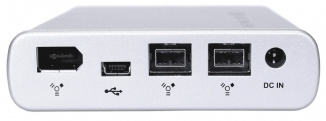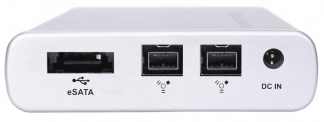
ToughTech XE Mini — Portable Pocket External Multi-Port Hard Drives
Company: WiebeTech
Prices: $120 – $425, depending on enclosure, speed, and capacity
http://www.wiebetech.com
This review has three parts: past, present, and future. The PAST was covered in David Weeks’ evaluation of the first generation of WiebeTech’s ToughTech Mini series drives, posted here. David’s conclusion was FireWire 800 doesn’t offer improved file transfer speed on this model, but every other aspect of this premium pocket drive is first rate.
The PRESENT is now, while I’m using and testing the XE series of ToughTech Mini. All WiebeTech XE models have three obvious ports on the rear, business end. What isn’t obvious is that the left-most port is dual-purpose: the same slot accommodates either a USB or an eSATA cable. I tested this new combo-port, and it works perfectly, when the drive has incoming AC electrical power.

FIREWIRE BUS ON ALL CYLINDERS
FireWire bus speeds are improved over David’s unit, so WiebeTech’s other two obvious ports are now both FW800. Not obvious is how easy it is to connect either FW800 port to any FW400 “traditional” FireWire computer jack via the included FW800-to-400 cable. I’m using every permutation of FW800/400 cables and ports on a daily basis, and the flexibility is grand. Be aware that using the included electrical power cable is a good idea if you’re pushing any external bus-powered drive to the limits of operation, whenever AC power is available.
WiebeTech’s support manager explains to MyMac.com: “Losing power for even a split second during a data transfer can cause data corruption. Unfortunately, AC power is becoming more necessary due to the increasing power requirements of newer hard drives and decreasing bus power provided by Intel-based Macs. Bus powering still works for a lot of configurations, but we include the AC adapter for those situations that require it.”
Hint: if you wonder why Apple places FW800 ports only on their professional machines and not on their amateur Macs, the next time you need to operate two or more simultaneous FireWire connections at different FW bus speeds, you’ll quickly understand the reason.
Suggestion: spend the extra money to buy larger, more powerful laptop and desktop Macs, and you’ll be glad you took the plunge, if you’re a power user or multi-external-drive person.
SOFT LOOK AT A HARD CASE
Before we examine performance of ToughTech XE Mini (or “TTXEM“), let’s take a brief detour to comment on WiebeTech’s new Pocket Drive Case that snugly fits and protects TTXEM. In the past, WiebeTech provided low-quality cases that were almost useless. Their new case is superb, constructed from stylish, thick, top-grain black leatherette (if such a thing exists) plus Velcro, and embossed with the company logo in bold-but-discreet orange color to match the hue on the WiebeTech.com web site. This $15.00 case is included when you purchase a TTXEM that contains a hard drive (as opposed to an empty shell enclosure), and will add to the envy-factor of your jealous colleagues and friends who are not wise or affluent enough to be able to buy a TTXEM — yet.
Important: do NOT attempt to operate your precious TTXEM when it is inside its case. The ports are not exposed, and, more important, this fan-free drive needs to have air circulation so it doesn’t become overheated. It gets w-a-r-m enough out in the open during extended usage.
OFF TO THE RACES
MyMac.com is not going to disassemble either of the two TTXEM units provided for our inspection. You can learn everything you need to know about them from the company’s web site or from email/phone communications with WiebeTech. Our goal here is to assess performance, styling, and value, not the circuitry.
Good news, pals: FW800 data transfers to/from TTXEM are 90-plus percent the speed of the much larger, faster, ToughTech WiebeTech desktop equipment, which received our very highest MyMac.com recommendation here. Give me real world, mission critical comparisons over benchmark lab tests any day of the week.
I created partitions on each of the two evaluation TTXEM units, corresponding to how my desktop ToughTech 400 and 800 drives (one each) are configured for weekly and monthly backups and data archives. Then I did side-by-side copying and backing up using both Finder select-drag-copy, and Super Duper cloning (from Shirt Pocket Software), which is my disk duping application of choice. Results are splendid, and surprising.
Speed checking was straightforward. My G4 PowerBook is a workhorse, and I can’t live without it. Four times on each of four days I SuperDuped the entire PowerBook back and forth between each of the four FW ports total on my pair of TTXEMs. Fastest time using FW800 was 31:36 and slowest time was 34:20, less than a three minute or ten percent time span. Average transfer time for the 14GB of my bazillion files was 33:33. Important: there was no quantitative difference in speed between WiebeTech’s 7200RPM/100GB unit and its 5400/160GB sibling. This is statistically improbable, but useful for customers, because 7200RPM external drives are more expensive than are 5400RPM ones. FW400-to-400 duplication timing ranged between 35:00 and 38:00 minutes, which is darn fast and consistent with previous FW400 experience.
MyMac.com asked Bill Head, technical director for WiebeTech, for a nuts and bolts explanation, and he wrote:
“The theory behind 7200 RPM drives vs. 5400 RPM drives is that faster-spinning platters reduce seek times and latency because the read/write heads spend less time ‘waiting’ for the next bit of data to come around. However, as you’ve discovered, this isn’t always the case in a real world application. In a long, sequential data transfer such as a drive duplication, the faster access times offered by a 7200 RPM drive are less important. However, if you’re using the drive as a boot drive or running applications off of it, the 7200 RPM drive would probably feel more responsive.”
Looking at WiebeTech’s catalog page for TTXEM, their 160GB/5400RPM model at $246 is only three dollars (yippee!) more expensive than the 100GB/7200RPM we reviewed, that should be faster but really isn’t. So at $1.50 per gigabyte of lightweight, impact-resistant, stylish, state-of-the-tech, bus-powered, FW800/400 storage, MyMac.com suggests you go for capacity over (alleged) speed. The 5400RPM drive runs a little cooler too, but that’s not a deal maker by itself.
eSATA FOR YOUR DATA

Let’s get back to that combination eSATA/USB2 port, which is starting to feel lonesome with all the emphasis on high-speed FireWire data transfers. We are familiar with USB, and you can read an extensive explanation of it, including a comparison with FireWire, here, but it may put you to sleep. Punch line: FireWire is much MUCH faster than USB on TTXEM and all other external drives we’ve examined at MyMac.com, but USB does come in handy as an optional second (or third) interface from time to time.
eSATA is not a native port on any portable Macintosh yet. Here’s a brain-numbing description of this new technology standard, that is supposed to surpass FireWire for transfer speeds. This was not our experience, using TTXEM’s eSATA port and cable. An eSATA connection must be powered using electricity, as opposed to a FireWire-powered AC-free connection. Being a first gen product, we’ll hope for accelerated eSATA rates as the technology develops.
Bill from WiebeTech explains to us: “eSATA is really just a connector type. The root technology is just plain SATA. In other words, an eSATA cable is the same as an internal SATA cable, but with more shielding and a different connector type. The Oxford 924 chip inside the ToughTech XE mini actively controls the FireWire and USB connections, but for eSATA it is just a straight pass-through from the drive to the port. Thus, the eSATA connection should be exactly the same speed as if the drive were installed inside the computer, assuming your eSATA host can also keep up.
“We suspect that the reason your eSATA speeds weren’t higher is that you were already getting the maximum speed of the drive itself. [Laptop] 2.5″ drives are typically too slow to saturate even the FW800 bus, let alone eSATA. You want a connection that’s fast enough to give you the full benefit of the drive’s speed, but anything extra won’t give you an added benefit. An eSATA port is a nice feature for people who have already invested in eSATA hosts, but speed-wise it won’t be any faster than FW800 for a single 2.5” drive. Where eSATA becomes a necessity is with multi-drive products employing RAID technology.”
My G4 PowerBook required an inserted 32-bit CardBus that adds two eSATAII ports via the card slot on a PowerBook’s left side. Different PowerBooks and MacBook Pros all use very different eSATA cards, so consult with WiebeTech for your specific model of Mac laptop. MacBooks and iBooks need not apply (sorry — no slots). An included CD installer walks you through a slightly confusing installation of software for your eSATA card, and WiebeTech phone support was very helpful when I had problems. WiebeTech does not manufacture these eSATA cards, and there is no brand name on mine.
eSATA is the FUTURE mentioned at the beginning of this review. You’ll be reading, hearing, and seeing more about it every month. I have very little experience and no special knowledge of it, but I know that having two more ports on any laptop is terrific, even though lab speeds don’t translate into actual file transfer speeds.
CONCLUSION
ToughTech XE Mini equals or surpasses all previous external hard drives we’ve reviewed at MyMac.com by WiebeTech or any other manufacturer. It’s not the cheapest, but it’s very close to being the fastest, sleekest, most durable and flexible unit of all. Special praise for its excellent Pocket Drive Case, but a tiny demerit for confusion installing the CardBus software.
MyMac.com rating: 4.5 out of 5

Leave a Reply
You must be logged in to post a comment.